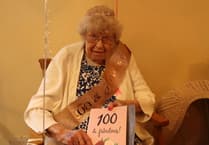Buster Keaton, Laurel and Hardy, Joan Crawford and Bill Murray are some of the stars seen in Petersfield thanks to the town’s two cinemas, the Electric Theatre and the Savoy Cinema.
Located on the same site between Swan Street and Chapel Street, where the Nationwide building society and the British Red Cross shop now stand, they spanned the golden age of cinema and were important to Petersfield’s social scene.
The Petersfield Electric Theatre was built in 1911 on the Swan Inn site and was a shed-like building with a one-level 300-seat auditorium.
There is no known documentation of its first decade apart from a 1920 cinema licence showing Walter Duffett as director.
In 1921 the Electric was taken over by the Filer family. Portsmouth businessman Hyman Filer became owner and his son Sol was appointed manager.
It screened the newest releases featuring the biggest stars of the day. Piano accompaniment to silent movies was provided by Mrs Le Goubin, and Mr Lemon used a scented spray to fight the smells of a crowded audience.
The Electric held its last matinee on April 27, 1935, and it was demolished nine days later to make way for a big modern establishment to cater for growing demand.
Heralded as Petersfield’s ‘New Super Cinema’, the Savoy covered 5,000 sq ft and had 1,000 seats.
Designed by Leslie Kemp and Fredrick Tasker – hailed as ‘among the best-known firms of architects in the country specialising in cinema design’ – it was a rare example of art deco design in Petersfield.
Its brick exterior and plastered interior were austere and functional, with little decoration and clean lines.
The Savoy was over two storeys. The ground floor was the shape of a saucer, so no seat was directly behind another, and the balcony was supported by a formidable girder whose arrival was an unprecedented event.
It had the latest air conditioning and heating, a powerful built-in cleaning system and the latest sound and screen equipment.
The grand premiere on August 12, 1935, featured performances by the Band of HM Royal Artillery among others, a Laurel and Hardy film, and a Pathé Gazette.
Sol Filer was still renowned for booking the very latest productions and often managed to get them ahead of, or at the same time as, Portsmouth.
But as early as the 1960s the decline of cinema started to be felt around the country and it accelerated in the 1970s and 1980s with changes in cinema distribution worldwide and competition from TV and video.
As a result bingo was introduced at the Savoy and it gradually became more prominent than films.
The Filer family said farewell to the Savoy in June 1978 and it was acquired by Spedeworth International Ltd, an Aldershot company specialising in racing cars.
Eventually, falling attendances meant the Savoy had to close and its last film – Ghostbusters – was shown on January 23, 1985.
The contents – including old posters and art deco items plus the projectors, seats and screen – were auctioned off at Whiteheads of Southsea. Days later the Savoy building was sold for more than £250,000.
It was bulldozed in 2008 and the only remaining evidence of 74 years of cinema is the Filer family archive, donated to the museum by Anthony Filer in 2008, and the Savoy lettering from the façade, also at the museum.
Anyone with memories of the cinemas can email [email protected] or call 01730 262601.




